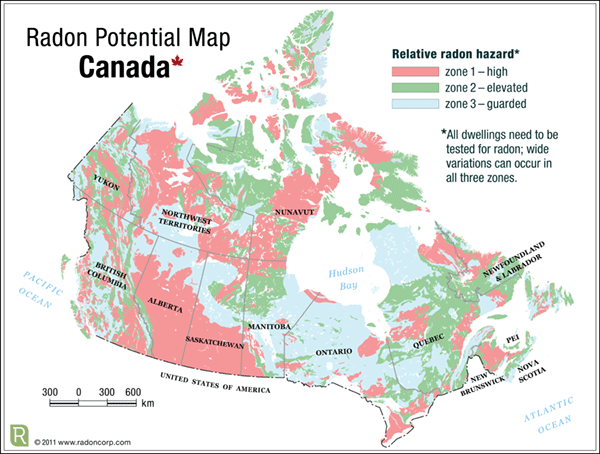Do houses in Edmonton have radon and how concerned should you be?
What is Radon?
Radon is an odourless, tasteless, colourless radioactive gas that is the by-product of uranium decay. Uranium occurs naturally in soil and rock formations, and creates uranium deposits, some Canadain provinces such as Alberta and Saskatchewan, have higher radon levels.
Radon seeps through the earth and into basements, where it can become trapped because of the efficient way our homes are sealed from the outside elements. Prolonged exposure to radon can lead to health problems, including lung cancer. In fact, after smoking, radon gas is the leading cause of lung cancer.
The Alberta Building Code 2014 included new requirements to protect homes from radon. The requirements came into effect in late 2015, and include, among other things, that new homes require a properly located radon rough-in or passive pipe in the basement, which can make it easier (and cheaper) to install a radon mitigation device in the future if it’s needed.
Does your Edmonton house have Radon?
It is important to know that homes anywhere in Canada can have dangerous radon levels. However, some of the homes in the prairie provinces have the highest average level of radon.
 Radon Gas Map, Canada. Source: Radon Environmental Management Corporation. 2011
Radon Gas Map, Canada. Source: Radon Environmental Management Corporation. 2011
How to test for radon
There are a few companies in Edmonton which will test for radon. This is becoming a more common contingency for home buyers. Long-term testing: tests of at least 90 days during the heating period (fall, winter, and spring) or during the height of summer when you may have air conditioning running provide reliable for determining radon levels.
Short-term testing: in Canada, some entities market and recommend short-term testing. Health Canada states short-term tests are not acceptable to assess radon levels as radon levels can vary significantly over time. Do not be misled, short-term tests do not provide buyers and sellers with an accurate indication of the likelihood of adverse radon levels.
- consider doing a 90-day radon test before listing your home; ensure you hire a certified professional for the test (the do-it-yourself kits are less reliable)
- if the radon level is 200 Becquerel or higher, you need to disclose that to potential buyers UNLESS you install a radon mitigation device before listing and the 90 day long-term test indicates the new radon level is below 200 Becquerel
- if the results from the test are less than 200 Becquerel, share the low test results with potential buyers as a potential selling feature
- if you don’t do a radon test before listing, be open to negotiations with a potential buyer that may include a holdback relating to the cost of radon testing and/or mitigation
- ask the seller if they have conducted a 90-day radon test
- if so, ask for the results of that test (if the result was 200 Becquerel or higher, the seller must disclose)
- if the seller has not conducted a radon test, talk to your real estate professional about reducing your offer by the approximate cost of radon mitigation
- alternatively, ask the seller for a holdback on your offer to purchase that will be released upon low radon test results OR in the event of a high radon test, the holdback funds will be used for radon mitigation with any funds remaining released to the seller after the mitigation device is installed
- if you buy a home that hasn’t had a radon test done, we encourage you to proceed with a radon test within 90 days of possession. This is health issue, and radon testing and mitigation is money well-spent. For more information about radon, go to Health Canada’s website and search “radon.”
The good news when it comes to radon is it’s a solvable problem. Even if you fall in love with a home that hasn’t had a radon test or the results are high, a radon mitigation device can be installed to vent radon gas outside the home from the basement. There are several proven methods to reduce radon in your home, but the one most used has avent pipe system and fan, which pulls radon from beneath the house and vents it to the outside. This system, known as a soil depressurization system, does not require major changes to your home.

